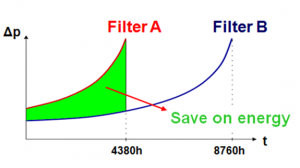Energy classification
The employment of energy-efficient air filters
can save on costs
Energy-saving products are coming more and more into focus. Particularly in case of products which are in daily routine use, these advantages cannot be dispensed with and sales are increasing constantly. And this is also a good thing. Because climate protection is playing an ever increasing role and it is important to reduce CO2 emissions. Why should this not be the case in ventilation and air conditioning as well? In the construction of new building complexes, it is attempted to take this aspect into consideration. But effective measures can also be taken with existing systems.
Those individual component parts in an air-conditioning system, whose pressure drop varies and which can be replaced without any great effort, are air filters. With the employment of frequency-controlled fans, a mostly unknown-of potential for economising can be opened up. This is especially obvious if the Total Life Cycle Costs (TLCC) are considered. 70% of these are energy costs, where procurement costs have a share of 20% and maintenance and waste disposal costs scarcely take up 10%. Therefore do not economise on the purchase of filters, because far higher costs arise from high energy consumption.
The energy consumption in overview
Until now only the pure performance of the filter has been important, thus how well filters can clean the ambient air of particles. How they deal efficiently with their energy used has not been relevant. However, if the energy consumption involved in the effort of overcoming flow resistance is considered, it is indicated that a third of the total energy demand of an air-conditioning system is used for this. Thus the evaluation of energy consumption is a subject very much in focus today.
Act sustainably
In order to take care of the environment and the budget, as well as to additionally reduce CO2 contamination, it is unavoidable that we pursue the minimisation of pressure drop in air-filter systems. This is because, with a steep pressure drop rise in the filters, energy consumption also increases strongly. These unsatisfactory resistance characteristics can be observed with numerous types of air filters.
The composite filter media from Kalthoff, consisting of electrically-uncharged, organic, synthetic fibres, guarantee a favourable rise of pressure drop with larger dust-holding capacity, and thus a high cost-effectiveness as a result of the progressive layering structure.
Because Kalthoff composite nonwoven filters work without artificially applied electrostatic charging, the separating efficiency is constantly resistant – even with varying air humidity levels and temperatures.
B-filters and C-filters are sometimes
exactly the right choice
At first glance, the Class A filter can be considered to be the most effective variant. However, if the ambient air is only slightly dusted, the installation of air filters is possible whose efficiency is less with respect to energy consumption. Also in case of air severely contaminated with dust, the requirement for clean air can be met by an increase of the filter surface area or by an additional filter stage. It is important in this case to determine the average value of the pressure drop during the entire service life and to keep it low. Depending on when the change of the filter occurs, standard filters with the classification B or C can also be used without any loss of benefit, and likewise represent an efficient solution. Therefore do not be deceived by first impressions, the better course of action is to be advised by us professionally.


